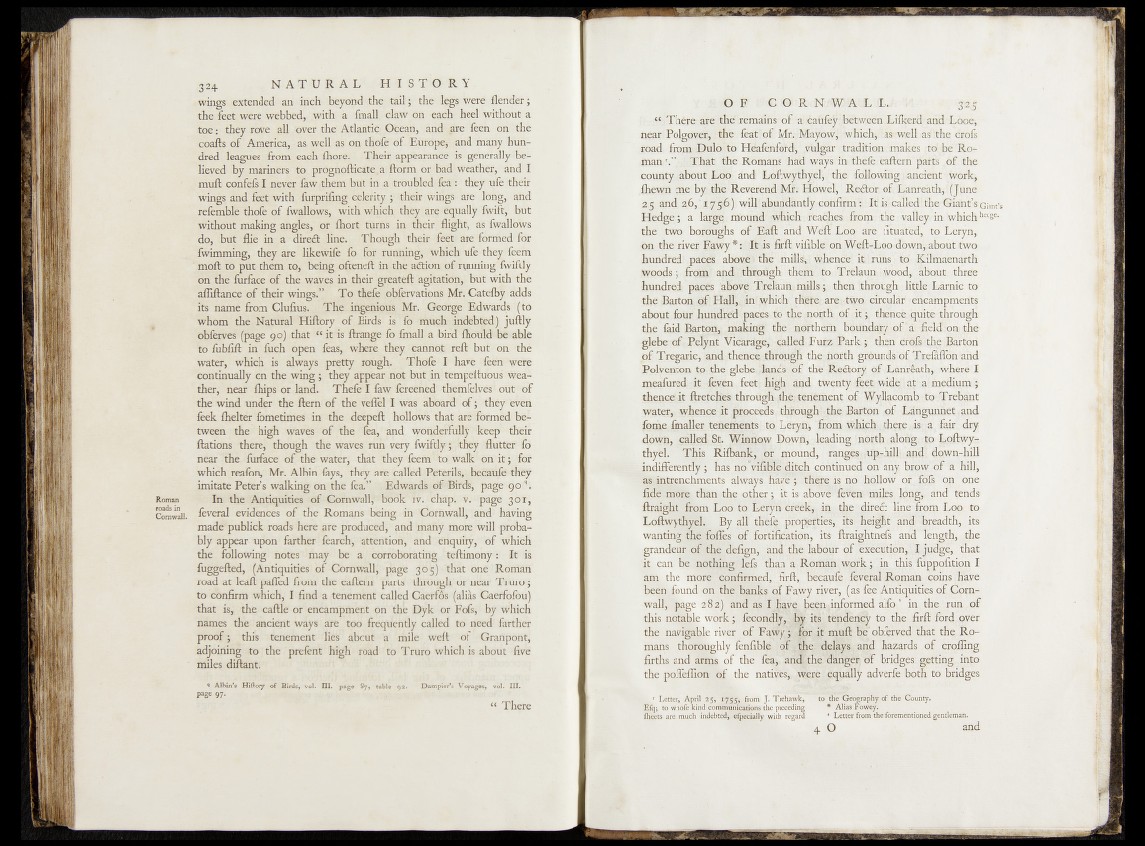
Roman
roads in
Cornwall.
m N-A T U R A L H I S T O R Y .
.wings extended an inch• .beyond'’the tail; thefogs were {lender;
the feeuwere webbed, ,with -à fmall, claw on eacfrf heel5 Without a
toe: they rove all lever the Atlariticj^Oeean, andere1 feéh ónt thé
coafts óf America,-as.well as on thofe of,Efoöpe'f-and riaapy bliri-
dred - leagues ^from; each; fliore.; Their appearân&e is ‘'generally -believed
by mariners to progriofticate^a ftormdE>j| bad* wëaÉhèf,rvaiuM
muil' cohfelàl never fewithem but in a troubled; fea*: they ufe 'their
wings and feet with furprifing celerity ; their wings- are lorig, and
relemble1”thole of fwallows, with which thëy' ar.e equally fwift, but
without making angles, or fhort tprôsjn ftipuv’flight, as fwallows
do, "but flie in.a-dire â line. Though their feet are’ formed*for
fwimming, they are likewife fo for running,. which ufe they feem
moft to put them to, being ofteneft in the adtion of-rynhing fwiftly
on the fiirface of the waves in their greatèft agitation, but with the
affiftance of their wings.” T o thefe ©bfervations Mr. Catelbÿ adds
its name from Clufius. The ingenious Mr. George ‘Edwards ?(;t0
whom the Natural Hiftory of, .Birds is? Ip rivuch indebted ij; ,j.ufrly
obferves (page 90) .that “ iris ftrange lb finall a bird Ihould be able
to fiibfift in fuch open fcas, where they cannot reft but 'éhü^thé
water, which is always pretty rough. Thofe I have fcen Vote
continually on the wing ; they appear not but ip'tetnpeftuOus Weather,
near {hips or land. Théfe I few fcreened themfelves: out of
the wind under the ftern o f the veflel I was aboard of ;r fhéy eVbtt
feek {belter femetimes in the deepeft hollows that are fórmèd between
the high waves o f the fea, and wonderfully keep theit
ftations there, though the waves run very fwiftly they flutter’ fr>
near the fiirfece of the Water, that they feenr tof walk1 on it; 'for
which realbn, Mr. Albin feys, they are called Peterils, becaùfe they
imitate Peter’s walking on the fea.” | Edwards of* Bit ds, page 4o4i
In the Antiquities óf-Gomwallf^lfeök ifiWhMp|-fe^p!a^
lèverai evidences of the Romans being in Cornwall, iâùd; MMri§;
made publiek roads here are produced, and mahy more Will -probably
appear upon farther fearch, attention, and enquiry, óf which
the following notes may be a corroborating Têftimony : It is
fuggefted, (Antiquities of Cornwall, page 3Ö5) that one Roman
road at leaft pafled from the eaftern parts through or near Truro ;
to confirm which, I find a tenement called Caerfôs (aliàs Gaerfofeuï
that is, the caftle or encampment on the Dyk Or Fofs; ' by which
names the ancient ways are too frequently called to need farther
proof ; this tenement lies about a mile weft of Granpont,
adjoining to the prefent high road to Truro which is about five
miles diftant.
1 AJbin’s Hiftory of Birds, vol. III. page 87, table 92. ’ Dampier’s Voyages, vol. III.
page 97-
“ There
5, p m
lSThere are the' rema'ifts ofÿaiiéaWèyybebween. LilkerH arid Looe*
near | PolgQvèv, I the feat!of ^r..yMay©jW^mhich’,' las -well >ashthe. drofe
road, fropi -Dukf to HdafenfcpR® ,vhlgàr -..trsjsUtion jtel^è'Romanr.|
M.That the Romans'hfed .ëaftern parts Jt& the
county .about Lop and L,oftw.jfthyelj t the. following Lancient* Work;
{hewn pae by the Reverend ;Mrj Howel, R-e^fofoori Tarirsâth,r(Jpne
2,5 and, 2.6,' 17516) will1 ahnsdàntly confirm”: It- is>called!the (Siatiti’s Giant’s
Hedge; a large., mound’ itefohes;; ftpnvkhe ; vallejvinilwhiich hedgethe
two boroughs of Baft iancf Wert.Ilo^^éuulBfamql tdjh‘efya<
on the river Fawy * : It is firft, vtSbfec on jWeftyliQOtdbwnsLafrout £w°
hundred paces above > the mift%I ^hpnçfe! ifelrujjs ; to foilmaenarth
woods; from andithroUgb' thefouto Trelaunthwood; 'abcaat^three
hundred paces above Tfolhunanajlls ; then ^through little Larjaic to
the Bartonof Hall,;in .which tBlSfec are^two circular1 ïqaçàfoppierits 1
about four hundred paces to tfiemoifh ofoit &enoefoui»te;^irough
the feid Barton, making the/ j^ th em b^dnda^y ijié
glebe of Pclynt Vicarage,’ call®! FuaZiiPark.a then cfiÉ&ahe iBartôn
JlfTregarie, and thence, through thejfvMth gf$anéw©£ ^©falfon farid 1
PqlVeittoii to the, glebeJlands -®£ the j jte^oaÿ efvLaps|ajth^nwhere I
meafured it feven feet; high ànd twçnty>^ej4|wi^i athalmeHium;}
jhenceit ftretchies through foé; tenement o f ’Wwfecoi|ihiJfooTreb^t
water, whence it proceeds through the Bart,on ,of-T]fog^nii£t fand
fome fipaller tenemfùts from \^ach^^!j^ana tlair’ dry
dowp, çàlled St. yi?innqw G^Kfe-foading
thyef. This Rifoanlç, ©r foounjJj raq^|rri%)rhjKh^3ffi
indifferendy ; has"no viuole,’ditch continued oiFa|yBfovy.pf T hill,
asfotrenchmen|s always nave; there is noIh^llow or^fois ©n one
fide more than the other ; S,-is above'feven-''‘rEHles longhand Çends
ftraight from Too to Eeryri creek, in the direâ Imûfoim to
Loftwythyel. By all tfrefe 'propsfties,' its height an^hreadth, rits
wanting jthe^foffes of fortification, its |traightne|s and length, J>he
grande^^.the defign, ariq'^e. labour Qf^l^riorij^Ijjtjdgé, that
it can Be nothing lefs than’a Roman Wjprk; '.in foiiiuppQfitjop I
am the more confirmed, firft, becaufe lèverai Roman coins ?fiave
been found' omthe banks of Fayvy river, fas fee Andqüities.<Æ.,porn-
wall, foage 282) and as I have been-iinformed alfo, in t,the run of
this nobble wotk| feconcfe*, by it-s , tendent to the firft ford^oyer
the navigable river of Fa^y^S-for.it muft be obferved that the. Romans
thoroughly fenfible of fdie delays,and hazards of crofling
firths and arms of the fea, arica the aangeft' of bridges getting ,inpo
the poffeflioft of the natives^,w.ere, Equally adverfe both to bridges
ij: r Letter, April 25, *755, from J. Trehawk, to the Geography of the County.
Efq; to whofe kind communications the preceding * Alias Fowey.
iheets are much indebtedj efpecially with regard • Letter from the forfetaentioned gentleman.
4. O and